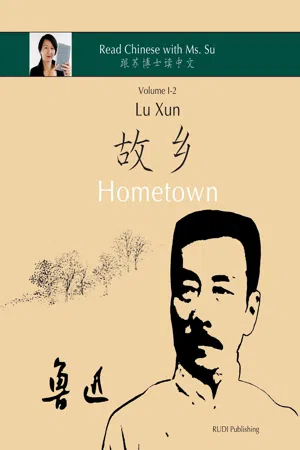
Lu Xun "Hometown" - 鲁迅《故乡》
in simplified and traditional Chinese, with pinyin and other useful information for self-study
- English
- ePUB (mobile friendly)
- Available on iOS & Android
Lu Xun "Hometown" - 鲁迅《故乡》
in simplified and traditional Chinese, with pinyin and other useful information for self-study
About this book
The books in the collection »Read Chinese with Ms. Su« are aimed at advancedChinese learners who are in the process of reading longer texts on their own.
In the autobiographical narrative Hometown, the great Chinese writer Lu Xun created two literary figures, namely the farmer’s son Runtu and the “Tofu Beauty” Madame Yang, which belong to the Chinese cultural memory.
The first-person narrator visits his hometown to dissolve the household of his now impoverished family. He was in a sad mood, partly because the homeland he had left more than twenty years ago was no longer that of his childhood. His friend Runtu, the radiant hero of his childhood, who now addressed him with “my master”, suffered from hunger and the turmoil of war. Nevertheless, there should be hope. At least that is what the first-person narrator wishes for at the end of his journey.
Hometown is a particularly lovingly told story of Lu Xun. The style is unusually gentle for this sharp-tongued critic, and the construction of the sentences more simple und fluid. This is typical of Lu Xun when he writes about the landscape and the people of his homeland.
***************************
The text Hometown has approx. 5000 characters, which are initially reproduced in the book in large font size and with pinyin. The word boundaries, which are normally omitted in a Chinese text, are indicated. Below the text line you will find explanations on word meaning, grammar, etc.; at the right margin of the page you will find a summary of the paragraph.
On the left pages of the book, the same text is printed in traditional Chinese characters, so that those who have learned simplified Chinese will quickly be able to understand the traditional characters with a little practice and vice versa.
At the end of the book, the texts are reproduced in normal print, i. e. in smaller font size, without any other information, as they would be found in a book from mainland China or Taiwan.
Frequently asked questions
- Essential is ideal for learners and professionals who enjoy exploring a wide range of subjects. Access the Essential Library with 800,000+ trusted titles and best-sellers across business, personal growth, and the humanities. Includes unlimited reading time and Standard Read Aloud voice.
- Complete: Perfect for advanced learners and researchers needing full, unrestricted access. Unlock 1.4M+ books across hundreds of subjects, including academic and specialized titles. The Complete Plan also includes advanced features like Premium Read Aloud and Research Assistant.
Please note we cannot support devices running on iOS 13 and Android 7 or earlier. Learn more about using the app.
Information
Table of contents
- Impressum
- Foreword
- About Lu Xun and the Text
- The Text《故乡》with Annotation
- The Text without Annotation in Simplified Chinese
- The Text without Annotation in Traditional Chinese
- Other Volumes of the Collection